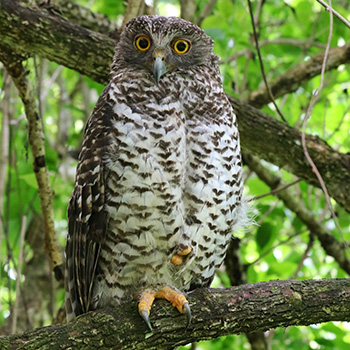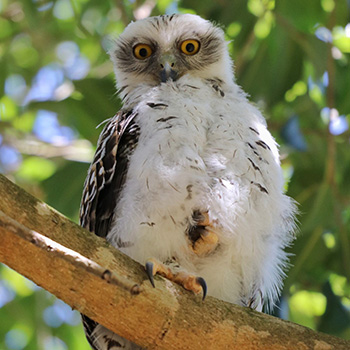Powerful owl
Protecting an elusive nocturnal predator: the powerful owl
With striking features, the powerful owl is a large, but elusive predator. Reliant on old forests, it needs our help to survive in Queensland.
Fast facts
Common name: Powerful owl
Scientific name: Ninox strenua
Family: Strigidae (night hawks)
Status: Vulnerable
Habitat: Open forests and woodlands with old trees containing sufficiently large hollows for nesting, and sheltered gullies in forests with dense understoreys.

Species overview
The powerful owl is an adept nocturnal hunter with its strong beak, piercingly sharp talons and bright eyes like night vision goggles.
The powerful owl is Australia’s largest owl but is hard to spot because it is quiet and inhabits dense vegetation. To locate the bird, scientists listen for its distinctive calls, particularly after dusk or in the early hours of the morning.
The owl lives mainly on the eastern side of the Great Dividing Range, from central Queensland to Victoria. Since European settlement, this owl has lost over half of its habitat. It is now found in urban areas or fragmented remnants of old forests.
Ecology and behaviour
The powerful owl is an apex predator, controlling the number of small mammals and birds in its ecosystem, thus maintaining balance in the forest.
The powerful owl’s long tail helps it navigate the forest. It swoops down on small mammals, like ring-tail possums and greater gliders, taking the prey with its talons.
The owl has a slow, double-note “whoo-hoo” call that is soft, but strong and resonant.
The powerful owl breeding season is in winter when the male prepares the nest in a vertical hollow of a large, old tree. The female incubates the eggs. After they hatch, the young stay near the hollow for several months to a year while the parents provide food and teach them to hunt.

Characteristics
The powerful owl is a large bird that has:
- a strong beak
- a long, rounded tail
- bright, yellow eyes set in a dark grey or brown facial mask
- large, yellowish feet with sharp talons
- a mottled appearance with V-shaped markings on an off-white underside and dark grey to brown feathers above.
Threats
- Habitat loss and fragmentation
- Human disturbance of nesting sites
- Climate change i.e. increasing the frequency and intensity of fires.
What’s being done?
- In partnership with conservation groups and local councils, we’re conducting surveys and research to monitor the powerful owl, gathering knowledge about its ecology, behaviour and adaptation to its changing habitat.
- We’re protecting powerful owl habitat by converting important parcels of land into national parks or conservation areas.
- We’re providing grants to community groups working to restore habitat for threatened species, including the powerful owl.

Who is helping?
- Queensland’s national parks and protected areas play an important role in protecting threatened species. As part of the Queensland Protected Area Strategy 2020–2030, we’re acquiring more land to expand our protected area system and help conserve critical species habitat.
- Birdlife Australia
With Queensland Government funding, this conservation group bought acoustic monitors and is engaging volunteers to do powerful owl surveys.
How you can help
- Join one of the citizen science projects aimed at powerful owl recovery.
- Submit powerful owl sightings to Birdlife Australia.
- Make your garden powerful owl friendly.
- Make a donation to support Queensland threatened species protection and science and research-based initiatives.
- Find out more about how you can help support threatened species efforts.